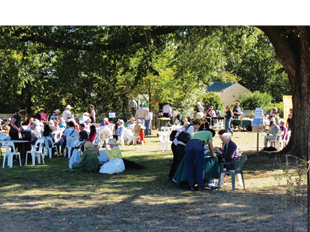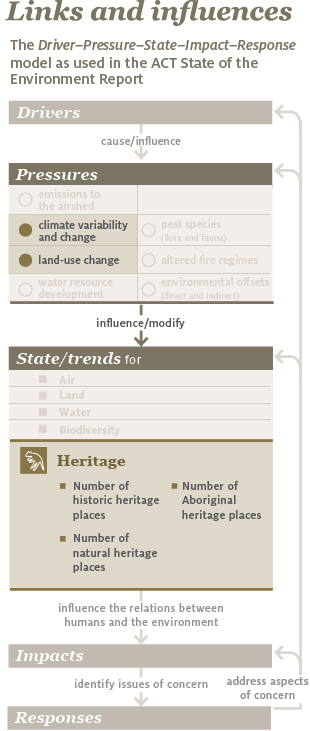This chapter assesses the state of heritage in the Australian Capital Territory (ACT), including trends in heritage conservation, using indicators based on the types of heritage included on the ACT Heritage Register and protected under the Heritage Act 2004. The chapter also examines the major pressures affecting heritage places and objects in the ACT, such as land use and development, and how these pressures affect the ACT’s heritage.
This chapter will:
- define heritage
- explain why heritage is important
- explain how heritage is measured
- describe the current state of heritage in the ACT
- assess whether heritage is stable, improving or declining
- describe the pressures on the ACT’s heritage and the impacts these pressures are having
- assess whether these impacts are stable, increasing or decreasing
- summarise government response mechanisms.
8.2.1 What is heritage?
Heritage can be broadly defined as objects, places and even traditions that have special historical, natural or cultural value, and are preserved for and passed on to future generations. Heritage may include aspects of the environment, including land, water and biodiversity.
The Burra Charter: the Australia ICOMOS Charter for Places of Cultural Significance 2013 (International Council on Monuments and Sites) defines the basic principles and procedures to be followed in the conservation of heritage places in Australia.1 The principles of the Burra Charter underpin heritage conservation and management at national, state and territory levels.
Heritage places and objects in the ACT are protected under the Heritage Act 2004. The Heritage Act states that the following types of heritage are to be recognised, registered and conserved:
- places and objects that have natural heritage significance
- places and objects that have cultural heritage significance
- Aboriginal places and objects.
The Heritage Act defines places and objects as follows:2
Object means a natural or manufactured object, but does not include a building or any other man-made structure.
Place includes the following:
(a) a site, precinct or parcel of land;
(b) a building or structure, or part of a building or structure;
(c) the curtilage, or setting, of a building or structure, or part of a building or structure;
(d) an object or feature historically associated with, and located at, the place.
The Heritage Act also defines the meaning of Aboriginal places, objects and traditions, as discussed in the Aboriginal Heritage section of this chapter.
What is considered to be heritage continually evolves over time, and depends largely on community perceptions of the place or item, and the role it plays in the life of the national, regional or local community.
8.2.2 Why is heritage important?
Heritage in the ACT tells the story of the history of the region, from the long custodianship of the land by the Aboriginal people to the growth of the modern city. This is significant in both a local and national context. Since Canberra was designed as Australia’s capital city, the history of the city is linked to the history of Australian federation and government, and is thus important for all Australians.
Heritage places and objects in an area can give the area a sense of character and give people a sense of belonging, providing ties to distant and more recent history. Heritage management and conservation aim to demonstrate and maintain the community’s sense of place in the region for present and future generations.
Heritage and human wellbeing
There are numerous ways in which heritage affects the wellbeing of individuals and communities. For instance, heritage can assist people to define their values and make life decisions by recognising and appreciating their connection to others in the past, present and future. Heritage can also deepen people’s sense of place, such as in the centenary of Canberra celebrations in 2013.3–5
For Aboriginal people, heritage and cultural identity have been recognised as a crucial component of physical and mental health – in terms of having access to culture and heritage, as well as having respected avenues for cultural expression.6–8
Places of heritage value can also contribute to human wellbeing through employment opportunities and the economic benefits associated with tourism. Canberra has a strong tourism industry, with heritage places – such as the nationally listed Australian War Memorial – that play a key role in attracting interstate and international visitors. Namadgi National Park offers similar opportunities for visitors with an interest in natural and Aboriginal cultural heritage.
Seen in these lights, it is not surprising that heritage can strongly influence people’s cultural identity and wellbeing. It is therefore often considered in environmental assessments – such as the state of the environment assessment – alongside life-enabling ecosystem services, such as fresh air and clean water.9,10
Heritage and ecosystem services
Heritage values and cultural identity are often considered examples of ‘cultural ecosystem services’. This is based on the fact that ecosystems underpin human culture, and that natural environments are often highly valued for their role in cultural life.

Elm Grove open day during the ACT Heritage FestivalPhoto: ACT Government
8.2.3 How do we measure heritage?
Despite our relatively young age as a city and Territory, Canberra and the ACT are rich in heritage. Our heritage consists of Aboriginal places and artefacts; historic places, and objects from our near and distant past; and unique natural places, landscapes and ecosystems.
The Heritage Act requires that heritage places and objects are listed on the ACT Heritage Register11 by the ACT Heritage Council. Places and objects must meet certain criteria to be entered onto the register. The strict measure of heritage in the ACT is the subjective assessment by the ACT Heritage Council against the criteria in the Heritage Act; however, a broad measure of heritage is seeing how many places or objects are listed on the ACT Heritage Register and how this is changing over time.
The following set of indicators used in this report to measure heritage reflect registration on the ACT Heritage Register and the pressures affecting heritage in the ACT:
- state and trend
- historic heritage places
- natural heritage places
- Aboriginal heritage places
- pressures
- land use and development.
